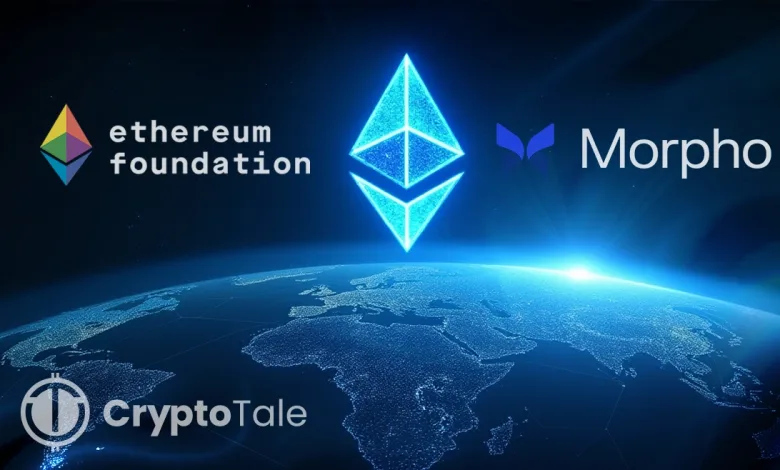Ethereum Foundation Deposits 2,400 ETH & $6M Stablecoins in Morpho

- Ethereum Foundation deposits 2,400 ETH and $6M stablecoins into Morpho to earn DeFi yield
- Morpho’s FLOSS licensing aligns with the Ethereum Foundation’s open-source DeFi principles.
- Ethereum Foundation expands DeFi treasury plan to balance ETH holdings and stablecoin yield.
The Ethereum Foundation has committed 2,400 ETH, approximately worth 9.6 million, and approximately 6 million worth of stablecoins into Morpho decentralized finance (DeFi) vaults. The relocation is an indication that the Foundation remains interested in earning on-chain yield and contributing to open-source DeFi infrastructure.
Morpho is a permissionless DeFi protocol that runs yield-bearing vaults, which enable participants to generate interest by lending its assets to lending markets. The Foundation has been making similar moves earlier this year, depositing approximately 120 million Ether in various lending protocols, including Aave, Spark, and Compound. The allocations are part of a larger strategy to diversify the Ethereum treasury and enhance its long-term sustainability by utilizing yield-generating positions in DeFi.
According to the Foundation, it intends to balance its treasury by combining active on-chain investments with fiat reserves. Before investing, it analyzes protocols in terms of security, liquidity, and risk management. The company has also looked to borrow on-chain stablecoins to finance research and development without selling large chunks of its Ether assets.
Related: Ethereum Foundation Plans 10,000 ETH Sale to Fund Grants
Morpho’s Open-Source Commitment and FLOSS Licensing
Morpho’s appeal lies in its firm adherence to the principles of Free/Libre Open Source Software (FLOSS). Its major products, such as MetaMorpho and Morpho Vault v2, are licensed under the GPL 2.0. Additionally, the Morpho Blue (v1) is currently licensed under the Business Source License (BSL) 1.1 but will be converted to the GPL 2.0 in January 2026. These licenses guarantee that developers are free to access, modify, and build on the codebase of Morpho.
The Ethereum Foundation has cited the open-source strategy of Morpho as one of the reasons for its investment. The Foundation promotes DeFi systems based on transparency, composability, and community-driven innovation by financing projects under the FLOSS license. The project is a continuation of its broader “cypherpunk” philosophy, focusing on decentralization, permissionless participation, and trustless architecture.
In its announcement, the Foundation stated that Morpho was a leader in permissionless DeFi. The organization also noted that “FLOSS licenses ensure that builders are free to fork and build on existing protocols”. The structure promotes the resilience of technology in the face of technological changes and helps preserve the openness of Ethereum-based finance.
Defi Allocations Reflect Strategic Treasury Evolution
In the first quarter, the Foundation borrowed $2 million in GHO stablecoins via Aave, indicating growing confidence in the on-chain liquidity market. These steps are part of a treasury strategy focused on yield generation and supporting the ecosystem.
Although some members of the community have criticized Ether sales as a means to finance its operations, the Foundation has gradually shifted its focus to yield farming to cover the costs of grants, research, and ecosystem development. The strategy minimizes the size of liquidations of ETHs but still exposes them to decentralized markets.
The Foundation’s 2025 policy said that it will expand its involvement in staking, lending, and tokenized real-world asset (RWA) markets. It plans to gradually grow its on-chain positions and focus on secure, liquid protocols.
In the meantime, Ethereum (ETH) is fluctuating between $3,900 and $4,100 as the crypto market remains volatile. Yet, despite the volatility of prices, on-chain activity has not decreased, and the foundation’s participation in the institution is used as a means to solidify Ethereum’s role in DeFi.





